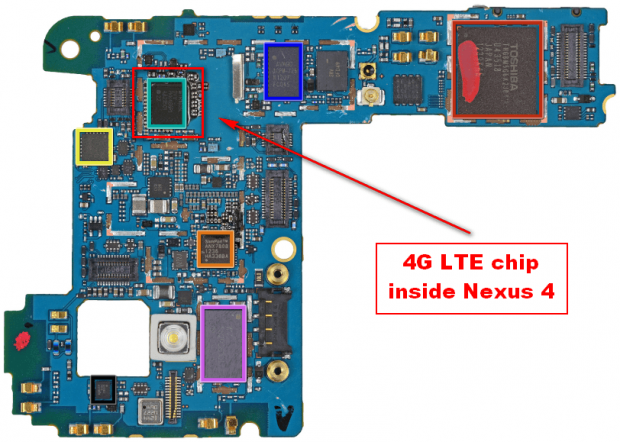iFixit has got their hands on a Nexus 4 and took it apart. Most of what they found was expected: NFC, battery, GSM/EDGE chips, processor, etc. One thing, however, did surprise — an LTE chip.
According to the iFixit teardown, the motherboard of the Nexus 4 comes with a Qualcomm WTR1605L OVV PKK486R1 chip. Google it and you find that chip is a multi-band 4G LTE chip. Why exactly does Nexus 4 have an LTE chip when 4G LTE isn’t a feature of the smartphone? And why doesn’t Nexus 4 support LTE when it has the freaking chip inside it?
The answer to the first question lies in manufacturing and design costs. You see the Nexus 4 is basically a modified LG Optimus G (which supports LTE). In essence, the Nexus 4 is an Optimus G but with modifications that Google required. LG may have found it cheaper to leave the LTE chip inside the Nexus 4 rather than modify its motherboard manufacturing process to remove the chip or commission a completely new design. After all, the cost of LTE chips isn’t as high as it used to be and reworking manufacturing or paying employees to design a new motherboard can be costly.
The answer to the second question is a bit more convoluted. At first people speculated that LTE was left out of Nexus 4 to help drive down costs. However, obviously that is not the case seeing as the Nexus 4 does indeed have LTE built-in. So then the lack of LTE if obviously a software issue. To understand why Nexus 4 doesn’t support LTE you must understand the main attraction of Nexus devices — fast Android updates.
The biggest reason (aside from cost, in the case of Nexus 4) people purchase Nexus devices is because the devices get updates to newer versions of Android faster than all other Android devices (and also because the support cycle for Nexus devices is typically longer than other devices). This fast-update-cycle causes issues when it comes to LTE.
You see LTE networks aren’t yet as “open” as traditional 3G networks. You cannot simply use an off-the-shelf 4G LTE device on any LTE network around the world like you can with 2G/3G phones; each network has its own specifications and requirements, and often require some sort of authorization. Sure while some LTE networks, such as AT&T, have pledged to be open, having LTE on a phone still requires software updates to be funneled through the carrier. As we saw in the case of Galaxy Nexus on Sprint and Verizon, carriers often delay software updates. (Galaxy Nexus on Verizon and Sprint received Android updates months after the GSM version of the device.) For Nexus 4 to support LTE, Google would have had to work with carriers around the world to push Android updates to the Nexus 4. Carriers, more likely than not, would have delayed the updates, which defeats the main purpose behind Nexus devices. This is (probably) why Nexus 4 does not support LTE despite having the hardware for it.
Of course the elephant in the room here is Apple and its fast iPhone updates, despite having LTE. The key thing to note with Apple is it has a lot more clout with carriers than Google simply because more people demand iPhones than Nexus devices. So Apple can push carriers around to prevent the delay of updates while Google cannot (yet).
That leaves the question: if the hardware is there, will Google enable LTE on Nexus 4 in a future software update? Maybe. We don’t really know. It is a possibility. Another possibility is that after-market mods and hacks could enable LTE on Nexus 4. However, any such mod would be unofficial, at-your-own-risk mods that could potentially brick your device. Is the risk worth the gain? That is for you to decide. Or, at least it will be when (if) the mods come out.
Anyone that wants to see the full iFixit teardown can hit up the source links below.
[via ArsTechnica, iFixit]

 Email article
Email article




